The pure soul[10] has been described in the 'Paramātmapada' of Ācārāṅga. We have presented that the same under the heading 'Concept of Soul[10][3]: Ācārāṅga and Upaniṣad'. The same soul[10] has been described in Samayas[6]āra[8] with the view point of niścayanaya. It will be relevant to discuss here about that. The soul[10] has been considered as devoid of colour etc. in Ācārāṅga. Samayas[6]ārā is also following the same concept of Ācārāṅga. Samayas[6]ārā is using the word 'jīva' instead of the word 'ātmā'. Both the words are synonymous in Jain philosophy, where as in Vedānta both have different meanings. There the word ātma denotes Brahma[2] and the word 'jīva' is used for a mundane soul[10]. Jain philosophy[5] does not ascribe this difference. Both the words are synonymous. In the context of describing the pure soul[10], Samayas[6]āra[8] has considered it free from colour, smell, taste, touch, shape, body[1], constitution and formation (Samhanana).
jīvassa ṇatthi vaṇṇo ṇa vi gandho ṇa vi raso ṇa vi ya phāso
ṇa vi rūvaṃ ṇa sarīraṃ ṇa vi sanṭhāṇam na sanhanana[9]ṃ[1]
As in Ācārāṅga here too the soul[10] has been considered beyond expression, description and words. By stating that soul[10] is inexpressible[2], Samayas[6]āra[8] has followed Ācārāṅga's representation of soul[10] as beyond word, logic and intellect. Ācārāṅga has addressed the soul[10] with the words such as formless existent, parijña (cognitive consciousness[4]) and samjña (knowing), etc. In Samayasara[7], the word 'cetanā guṇa' is available which assists this concept and denotes both - the soul[10]'s incorporeality and cognitivity.[3]
 Dr. Samani Mangal Pragya
Dr. Samani Mangal Pragya
